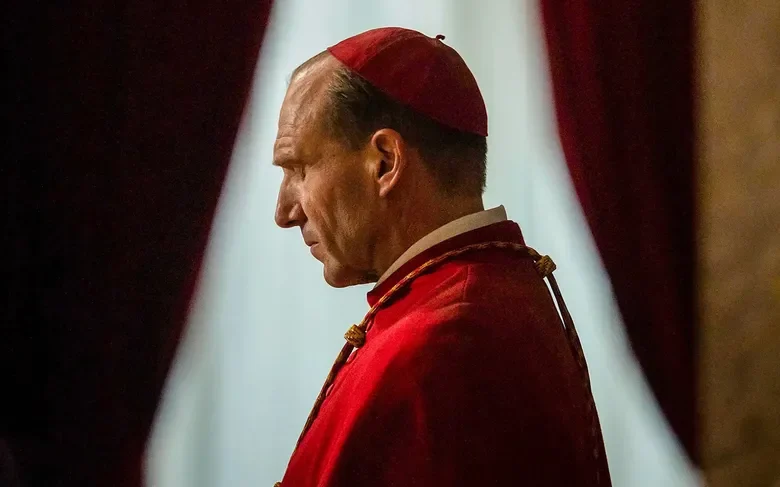So far, a strong contender for Best Picture in 2025 is Edward Berger’s political drama Conclave, a film that brilliantly explores the inner workings of the election of a new Pope. It powerfully showcases the mystery, uncertainty, and conflict that inevitably arise when such a rare and significant event takes place.
I’m not going to delve into the conclusion of the papal conclave in this review, thereby spoiling the film. I do want to address major criticisms of the film as anti-Catholic.
Among Catholics, there is a common perception that the movie paints the Catholic Church in a negative light. In this piece, I hope to provide valuable insights into the film’s techniques and to shed light on the deeper nuances of its narrative. More importantly, my goal is to shift public opinion by demonstrating that the film actually highlights the Catholic Church in a profoundly positive way, and should be viewed by Catholics and non-Catholics alike.
Conclave focuses on Cardinal Lawrence, played by Ralph Fiennes, who is the Dean of the College of Cardinals and is in charge of managing the vote and overseeing the Cardinals during the papal election.
The story predominantly unfolds in Casa Santa Marta, the location where the Cardinals are sequestered, and in the Sistine Chapel, where the actual voting takes place.
The atmosphere of the film is phenomenal. Though not everything is set in one room, the space is limited, yet the cinematography makes excellent use of it. The distinct white corridors, pauses in bedchambers, expansive shots of clustered cardinals congregating in courtyards, and the stunning artwork in the Sistine Chapel all contribute to the atmosphere of secrecy and gravity.
With Cardinal Lawrence, the camera often follows him down corridors from behind, the sound focusing on his heavy breathing as he walks with pace and determination. The increasing intensity of the Cristal Baschet score further amplifies the sense of importance during this time of uncertainty, particularly with the “front-runners” of the election facing suspicion.
Around 30 minutes into the film, the first day of the Conclave begins, and Cardinal Lawrence delivers his introductory homily.
He starts in Italian, accompanied by side profile shots, but then something overtakes him, and he switches to his natural language: English. He speaks from the heart, expressing his doubts and uncertainties about the Church, and about who should be the next Pope.
He emphasizes the need to embrace doubt, sin, and the human condition, and asking for forgiveness. As he begins to speak more authentically, the camera shifts to a frontal, close-up shot, and the scene becomes one uninterrupted shot, with a slight push-in as he continues to speak. He becomes so absorbed in his words that he loses awareness of those around him.
His final line: “If there was only certainty and no doubt, there would be no mystery, and therefore no need for faith. Let us pray that God will grant us a pope who doubts.” These closing words are delivered with notable conviction.
A recurring motif in the film shows Lawrence looking up at Michelangelo’s iconic Last Judgment fresco. In these moments, I believe he is contemplating how God will judge his decisions, as well as those of the other Cardinals, in choosing the next Pope.
His doubt and uncertainty make him human, and we relate to him. It is his authenticity and truth to himself and his beliefs that persist throughout the film, allowing him to expose unworthy candidates and confront election rigging and abuses of power.
While some may dismiss the movie as a slight at the Church, the crises depicted feel more personal than institutional. They are not broad indictments of the Church but rather individual dilemmas. The negative portrayals of Cardinals are really a meditation on various aspects of the human condition, such as pride, anger, and greed.
The fact that the cast of Cardinals reflect some of those sinful tendencies themselves is not a negative for the Church; rather, it demonstrates that the Church is both a refuge and salvation for sinners.
Many Catholics might see this film as a tarnishing of the Catholic Church; however, I do not.
The lead character stands for everything that is right. His non-traditional, controversial homily near the beginning of the movie lays the groundwork for his ideals and morals. His constant looking up at the Sistine Chapel art symbolizes his seeking for justice, despite his doubts.
He represents the truth of the Catholic Church, and I believe this is the central message of the film. While there are problems, they are a reality, and the Cardinals are also human beings with their own pasts.
Rather than focusing on these flaws, the film emphasizes the search for a just leader, despite these personal dilemmas.




